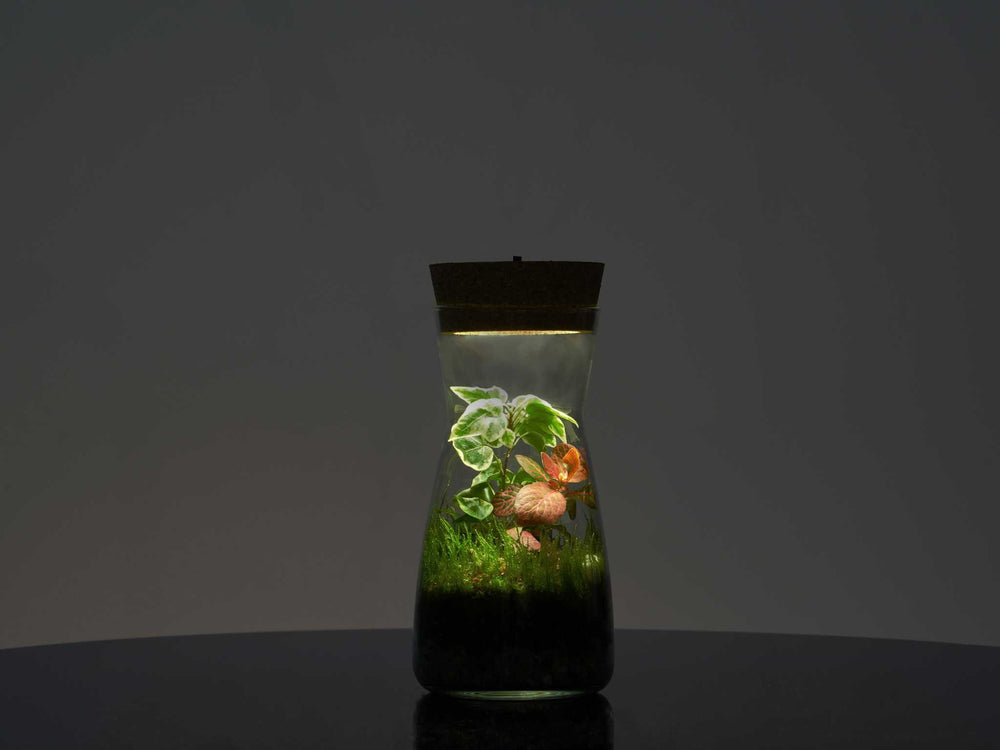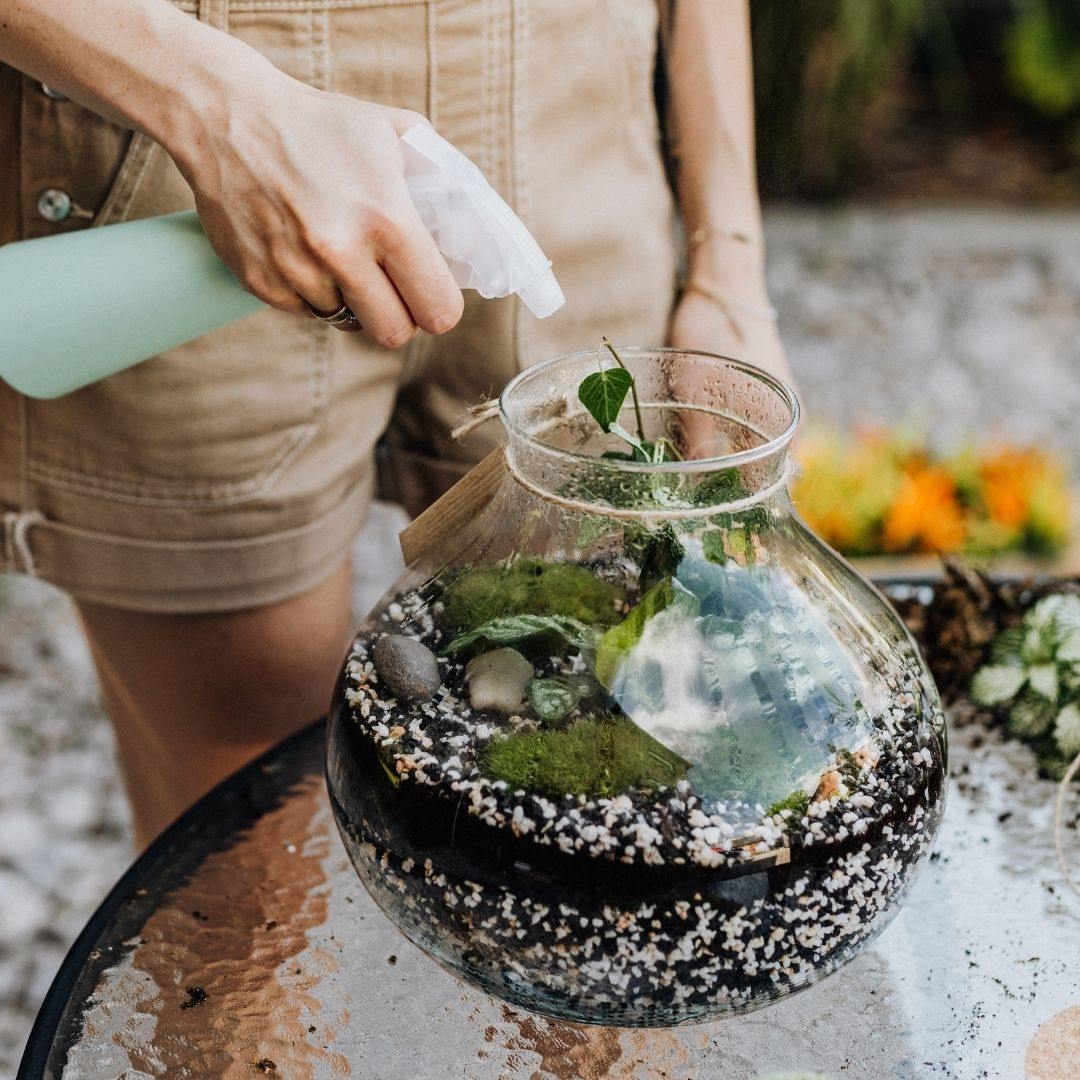How Do You Keep a Terrarium Alive?
Terrariums are miniature gardens that bring a touch of nature indoors, making them a beautiful and low-maintenance addition to any space. They can be open or closed, creating unique environments for various types of plants. The allure of terrariums lies in their self-sustaining nature, making them relatively low-maintenance and perfect for busy lifestyles. Whether you choose an open or closed terrarium, each has its own charm and benefits. But like any living thing, they need some TLC to thrive. Whether you're new to terrariums or looking to improve your green thumb, this guide will walk you through everything you need to keep your terrarium alive and flourishing.

Choosing the Right Plants for Your Terrarium
Selecting the right plants is crucial for the success of your terrarium, as the health and aesthetic appeal of your miniature ecosystem depend on it. Different plants thrive in various environments, so understanding the specific needs of each plant is essential in matching them to the type of terrarium you have. For open terrariums, which typically experience more airflow and less humidity, succulents and cacti are excellent choices. These resilient plants prefer dry conditions and can survive with minimal watering, making them ideal for environments where excess moisture can be detrimental.
On the other hand, popular choices for closed terrariums include the Parlour Palm, which adds a touch of elegance with its feathery fronds, and Fittonia, often called the Nerve Plant, known for its striking vein patterns and vibrant colors. Additionally, ferns bring a lush, green vibe, while Calathea adds unique leaf patterns and colors that can brighten up any space. The Coffea Arabica, or Coffee Plant, not only serves as a delightful nod to coffee lovers but also thrives beautifully in the humid, low-light conditions typical of a terrarium.
By carefully selecting compatible plants that flourish in similar environments, you not only enhance the visual appeal of your terrarium but also set the stage for a thriving miniature garden that can flourish over time. This thoughtful selection process ensures that each plant can cohabitate harmoniously, leading to a balanced ecosystem that flourishes together.

Watering and Humidity Control Tips
One of the most crucial aspects of terrarium care is watering, a simple yet often misunderstood task. Overwatering is a common mistake that many new terrarium owners make, particularly in closed terrariums, where moisture is naturally retained within the glass environment. This can lead to excess humidity and potentially harm the plants. For closed terrariums, the rule of thumb is that less is more; it's essential to be cautious with the amount of water you provide.
To ensure your plants thrive, regularly monitor the soil and the health of the plants. It's important to keep an eye on your plants and moss. If the plants begin to wilt, it may indicate that your terrarium needs watering. Conversely, if the moss starts to lose its color, a light spray can help revive it. By paying attention to these details, you can maintain a healthy and vibrant mini-ecosystem that flourishes over time.
Open terrariums need more frequent watering because of higher evaporation rates, but it's crucial to avoid overwatering. Use a watering bottle with a nozzle to gently moisten the soil beneath each plant, ensuring it doesn't become waterlogged.
Humidity control is essential, particularly for closed terrariums. If you notice condensation forming on the glass and remaining all day long, it's a sign that the humidity levels are too high. Simply open the lid for a few hours to allow excess moisture to escape. Maintaining the right balance of humidity will keep your terrarium healthy.
Light Requirements for Different Terrariums
Light is another critical factor in terrarium care. Different plants have varying light requirements, so it's important to place your terrarium in the appropriate location. Succulents and cacti in open terrariums thrive in bright, indirect light.
For closed terrariums with tropical plants, place them in a spot with indirect light. Direct sunlight can cause the temperature inside the terrarium to rise, potentially harming the plants and the glass. If natural light is insufficient, consider using artificial grow lights to provide the necessary amount of light..
Insufficient light in closed terrariums can significantly impact the health of your plants and the internal humidity levels. Without adequate light, plants may struggle to perform photosynthesis effectively, leading to leggy growth and pale, weakened foliage. This lack of vitality not only affects plant appearance but also their overall health, making them more susceptible to diseases.
Monitoring the light levels and adjusting the placement of your terrarium accordingly will help ensure the plants receive the right amount of light for healthy growth. Keep in mind that achieving the ideal light balance may require some patience. Monitor your plants' reactions closely and be prepared to adjust the light source if you observe any signs of distress, such as yellowing leaves or a washed-out appearance.

Pruning and Trimming for a Neat Appearance
Regular pruning is an essential part of terrarium maintenance. Over time, plants may outgrow their space, and dead leaves or stems can accumulate, potentially hindering the growth of healthy foliage. By trimming back any overgrown or dead plant material, you help your terrarium maintain its neat appearance and prevent overcrowding.
When you notice leaves turning yellow, wilting, or dying, carefully remove them to promote fresh growth. This practice not only keeps your terrarium looking tidy but also helps your plants conserve energy, directing it toward healthy, vibrant growth.
Monitoring Temperature
Terrariums thrive best in stable temperatures ranging from 15°C to 24°C. It’s essential to keep your terrarium away from direct heat sources like radiators or air conditioners, as sudden temperature fluctuations can stress your plants. Place your terrarium in an area with consistent room temperature to maintain an ideal environment for your miniature ecosystem.
Managing Mould in Closed Terrariums
Mould can sometimes become an unwelcome guest in closed terrariums, but with a few careful strategies, it's entirely manageable. This often occurs due to the high humidity levels that are characteristic of sealed environments. To tackle mould effectively, it's important to first monitor humidity levels closely and adjust them as needed, ensuring there's adequate but not excessive moisture. You may also introduce springtails, which are tiny beneficial insects that help control mould by feeding on decaying organic matter.
Additionally, periodically airing out the terrarium can help regulate humidity and reduce mould spores. If you spot small amounts of mould, carefully remove it with a piece of tissue or paper towel, making sure not to disturb nearby plants. Regular maintenance, vigilant observation, and a little preventive care will keep your terrarium fresh, healthy, and mould-free, allowing you to enjoy its beauty without concern.

Observing and Adapting to Your Terrarium’s Needs
Every terrarium is unique, and part of the joy of caring for one is observing how it evolves over time. Be attentive to the signs your plants give you – if you notice yellowing leaves, mold growth, or wilting, these are signals that something may need adjusting. Perhaps the light is too intense, the humidity is too high, or the plants need a bit more space. Adjust your care routine accordingly, and don't be afraid to experiment until you find the right balance.
Common Mistakes to Avoid in Terrarium Care
Even with the best intentions, mistakes can happen. Understanding common pitfalls can help you avoid them and keep your terrarium thriving. One of the most common mistakes is overwatering, which can lead to root rot and fungal growth.
Another mistake is placing the terrarium in direct sunlight, which can cause the temperature to soar and stress the plants. Choosing plants with incompatible care requirements is another error that can lead to imbalances and poor growth.
By being mindful of these common mistakes and taking proactive steps to avoid them, you can set your terrarium up for success.

Troubleshooting Guide for Dying Terrariums
If you notice your terrarium showing signs of distress, don't panic! There are several troubleshooting steps you can take to revive it. First, check for signs of overwatering or underwatering and adjust your watering routine accordingly.
Examine the light conditions and ensure your terrarium is receiving the appropriate amount of light for the plants inside. If you notice yellowing leaves or mold growth, it may be a sign of poor ventilation or excessive humidity. Open the lid of a closed terrarium to improve air circulation.
Sometimes, specific plants may not be thriving due to compatibility issues. Consider replacing struggling plants with ones that have similar care requirements to create a more balanced environment.
Encouragement and Tips for Long-Term Terrarium Success
Creating and maintaining a thriving terrarium is a rewarding experience that brings nature into your home. By following the tips and guidelines outlined in this guide, you can enjoy the beauty and tranquillity of a healthy terrarium.
Remember to observe your plants regularly, make adjustments as needed, and enjoy the process of nurturing your miniature garden. With a little care and attention, your terrarium will continue to flourish for years to come.
If you're looking to start your terrarium journey, check out our DIY terrarium kits available on our website! Each kit includes everything you need along with step-by-step guides to help you create your own green masterpiece.













Leave a comment